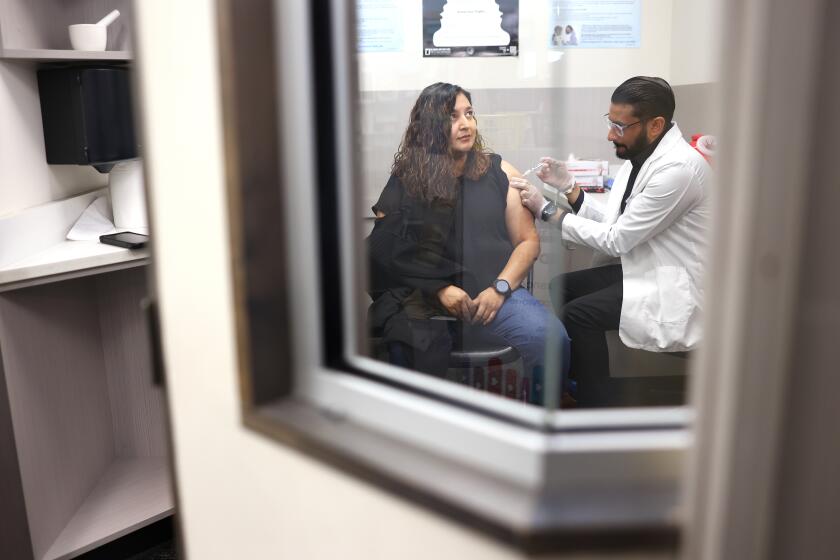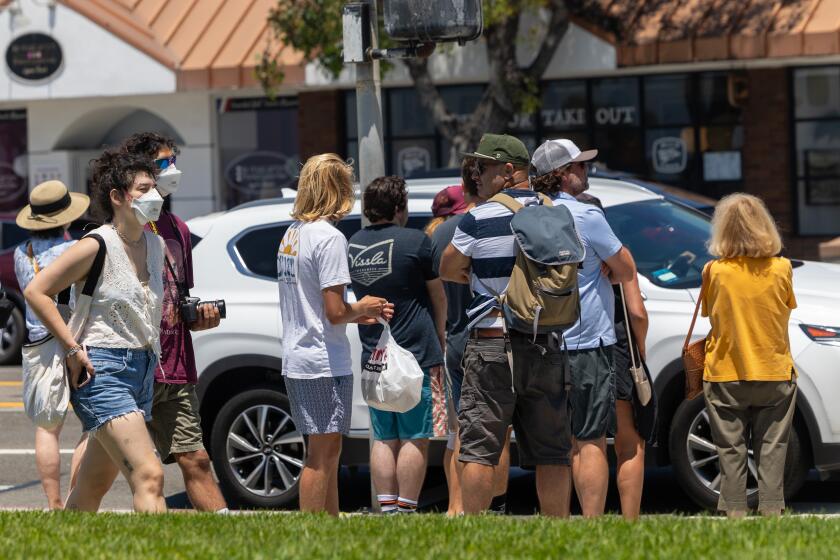Early signs California’s COVID surge is peaking: ‘It’s not gone away. It’s just lower’

- Share via
Unlike recent temperatures, California’s COVID summer may no longer be heating up — though officials caution the virus continues to circulate at levels plenty high enough to pack a potent infectious punch.
Any discernible slowdown would still be welcome news for the virus-weary state, however. And although it’ll take a few more weeks of measurement to confirm the trajectory, health officials hope the release of updated vaccines will help further dent the wave.
“It’s not gone away. It’s just lower. It’s just gone from ‘very high’ to ‘high,’” said Dr. Peter Chin-Hong, a UC San Francisco infectious diseases expert.
California has endured “high” levels of coronavirus in its wastewater since early June, and “very high” levels since July. But for the week ending Aug. 31, the most recent data available, California’s coronavirus sewage levels fell back to “high,” according to the U.S. Centers for Disease Control and Prevention.
COVID remains at stubbornly high levels in California, and officials warn that transmission could again accelerate following the busy Labor Day holiday weekend.
California is also now one of 16 states in which COVID is estimated to be “declining” or “likely declining,” the agency said.
COVID levels in wastewater are considered “high” or “very high” in 44 states and the District of Columbia, and “moderate” in four. There were no estimates for the two remaining states, according to the CDC.
Other states where COVID is estimated to be “declining” or “likely declining,” the CDC said, include Texas, Florida, New York and Illinois. COVID is thought to be “growing” or “likely growing” in seven states, including Michigan and Washington. COVID’s trajectory was “stable or uncertain” in 24 states and the District of Columbia, and there were no estimates for three states.
But not all metrics are moving in the rosy direction, and doctors have cautioned transmission could once again rebound on account of travel and gatherings over Labor Day weekend. It’ll take another week or more to get a better sense of how the holiday may influence COVID trends.
In California, more than 13% of coronavirus tests for which there is an officially recorded result came back positive over the week ending Sept. 2 — higher than the peaks seen both last winter and summer. A month ago, the figure was 12%, according to the California Department of Public Health.
In Los Angeles County, coronavirus levels in wastewater were at 75% of last winter’s peak for the 10-day period ending Aug. 24. That’s down from the reading of 86% for the 10-day period that ended Aug. 17.
Doctors and scientists are keeping an eye on yet another coronavirus subvariant — XEC — that could surpass the latest hyperinfectious strain.
Official coronavirus case counts have declined, though reporting may have been interrupted by the Labor Day holiday.
For the week ending Sept. 1, there were an average of 381 coronavirus cases reported daily in L.A. County, down from 410 the prior week. Those counts include only those infections confirmed at medical institutions and don’t reflect the results of at-home tests. Fewer people are testing at all when they’re sick.
“We’re seeing, I would say, somewhat of a cresting of cases,” said Dr. Elizabeth Hudson, regional chief of infectious diseases for Kaiser Permanente Southern California.
There are certainly new COVID patients coming into doctor’s offices and clinics, but the overall numbers as of Friday no longer appear to be accelerating as they were a month ago, Hudson said.
The percentage of emergency room visits related to the coronavirus across L.A. County has hovered at a relatively high level for the past six weeks, at between 3.7% and 4.3%. Last summer peaked at 5.1%.
Doctors urge people who are experiencing respiratory problems to see a medical professional who can check their symptoms and test to determine what their illness is.
Coronavirus-related hospitalizations in L.A. County remain relatively high for this summer but are not increasing. For the week ending Aug. 31, there were an average of 447 coronavirus-positive people in hospitals in L.A. County per day, down from the prior week’s seasonal high of 499. Last summer’s peak was 620.
In the San Francisco Bay Area, coronavirus levels in sewage have also declined. Coronavirus levels are now considered “medium” in the sewersheds of San José and Palo Alto, and “low” in Sunnyvale, according to the Santa Clara County Public Health Department.
And at UC San Francisco’s hospitals, there were about 10 coronavirus-positive patients as of Friday, down from the seasonal peak of roughly 30.
COVID deaths have ticked upward, an expected development reflecting the summer transmission increase. L.A. County averaged about 2.7 COVID deaths a day over the week ending Aug. 13, the most recent for which data are available — up from the average of between 1 and 2 that had held steady since early July.
The updated COVID-19 vaccine could be available any day, a promising development for California and the nation amid a potent and enduring summer wave of the disease.
Deaths have also been on the rise nationally. For the week ending Aug. 10, 971 COVID deaths were reported. That’s more than double the weekly tally from the start of summer, but only two-thirds as many as the 2023 midyear peak.
In a statement, the L.A. County Department of Public Health said it “will continue to monitor COVID-19 data in the coming weeks to better understand if we have truly passed this summer’s peak.”
Even with COVID potentially on the downswing for now, doctors are urging people to get their COVID and flu vaccinations for the fall, when both viruses typically begin to pick up steam. Australia was recently hit with a significant wave of flu during its winter, and U.S. doctors look to the country’s experience as a potential sign of things to come.
“They saw an early start to their flu season with a very large number of cases. ... We expect to see a pretty robust flu season,” Hudson said. “Getting your flu vaccine now ensures your protection for the entire flu season.”
The CDC says September and October are generally the best times for most people to get a COVID shot, though there are other factors to consider.
The CDC recommends that everyone age 6 months or older get this season’s updated COVID and flu vaccinations. The best months to get them are in September and October, according to the CDC, and people can get both shots during the same visit.
There are also ways to get vaccinated for flu without getting a shot. One option, called FluMist, is available as a nasal spray for nonpregnant people ages 2 to 49. There is another needle-free flu vaccine option, called Afluria.
As for when exactly is the ideal time to get vaccinated, doctors offered varying advice.
Hudson suggested getting both vaccines now — as she already has.
“It’s so easy for all of us ... to put things off,” she said. “This is the time to really do it. Do it before we start to get busy with all the stuff that comes with the holidays, with the kids going back to school.”
California’s strongest summer COVID wave in two years is still surging, fueled in part by the rise of a particularly hyperinfectious FLiRT subvariant known as KP.3.1.1.
The shots have been widely available at stores like CVS, Walgreens, Rite Aid, Ralphs, Vons, Albertsons, Pavilions and Safeway. As of Monday, updated COVID vaccines will be available at Kaiser’s California locations for people age 5 years and older. For babies and younger children, vaccinations will probably be available in mid-September.
Sutter Health expects to begin offering COVID vaccinations in mid- or late September.
“By taking one of these vaccines, that’s a really good way for us to potentially nip this current wave in the bud,” Hudson said.
Chin-Hong suggested it’s important that older and immunocompromised people get their vaccinations done now if they haven’t been vaccinated against COVID in a year or more. But for younger people who aren’t immunocompromised, he suggested a sweet spot for timing COVID and flu vaccinations is October, which would be closer to the expected peaks of the autumn-and-winter COVID-and-flu season.
Older people who last got vaccinated in the spring can probably wait until October for another dose, Chin-Hong said.
The COVID vaccination will boost protection against severe illness and hospitalization for at least a year, Chin-Hong said. But one reason to consider waiting until October is that the best protection against infection is within roughly six to eight weeks after getting the shot. That window can be wider if the vaccine is a close match to circulating subvariants, Chin-Hong said.
He said he plans to get his COVID and flu vaccinations in mid-October.
The new flu and COVID vaccines are specifically formulated to protect against particular viral strains that officials feel will be prevalent this fall and winter.
If you’re trying to time your COVID vaccination for maximum protection against infection ahead of a big event, like a vacation, about two weeks ahead of time is a safe bet. Chin-Hong said immunity revs up just a few days after the shot, but the biggest benefit is reached starting about a week or two afterward.
It’s also especially important that pregnant moms-to-be get vaccinated against COVID.
“For them ... if they want to protect the baby, they should really get it at least two weeks before they deliver,” Chin-Hong said. “The antibodies have to cross the placenta,” and that takes time.
Masking in indoor public settings also remains a prudent idea for those seeking to avoid getting infected, Hudson said.
Reducing the risk of a COVID infection also cuts down on the risk of long COVID, and the significant health problems it can cause. Sérgio Mendes, the legendary Grammy-winning Brazilian musician, died Thursday at the age of 83 in Los Angeles, and his family said his health “had been challenged by the effects of long term COVID.”
Generally speaking, long COVID can contribute to a wide variety of ailments, including difficulty breathing and shortness of breath — as well as difficulty maintaining blood pressure. For some people, long COVID can begin a series of health problems that persist for months, or even years.
The U.S. has approved the first vaccine for human respiratory syncytial virus, or RSV, to protect older adults.
The CDC also recommends vaccination against the respiratory syncytial virus, or RSV, for everyone age 75 and up, as well as for adults age 60 to 74 at increased risk of severe RSV. The RSV vaccine is not annual, meaning people who got one last year don’t need to get another one at this time, the CDC said. It can also be administered during the same visit as flu and COVID shots.
An RSV vaccine is also available for expectant mothers at weeks 32 to 36 of pregnancy to pass protection on to their fetuses. An RSV antibody is available for babies and some young children, too.
Times staff writers August Brown and Alexandra Del Rosario contributed to this report.
More to Read
Sign up for Essential California
The most important California stories and recommendations in your inbox every morning.
You may occasionally receive promotional content from the Los Angeles Times.



















